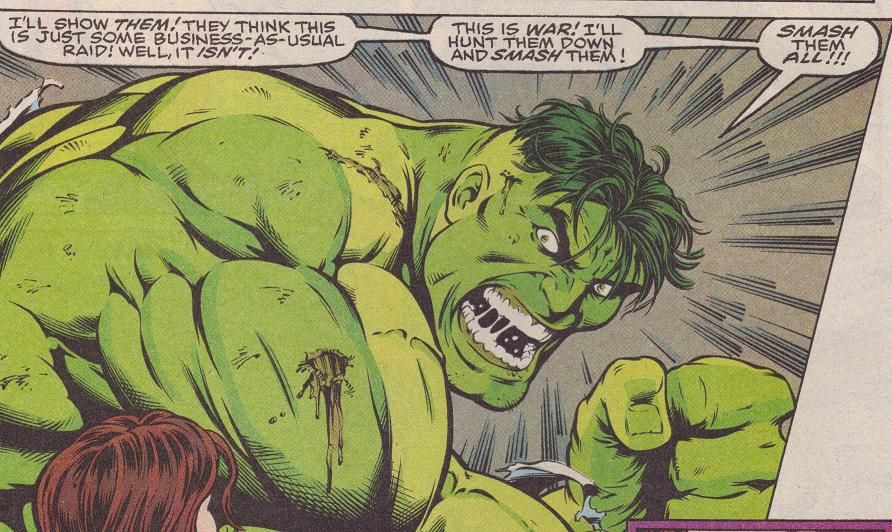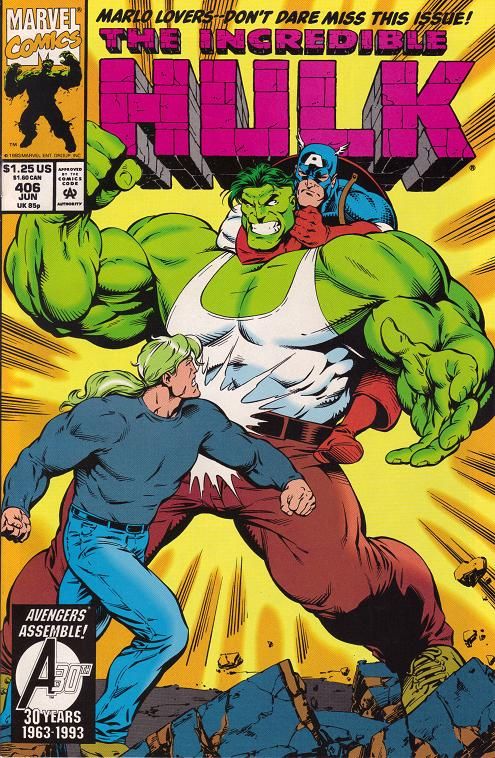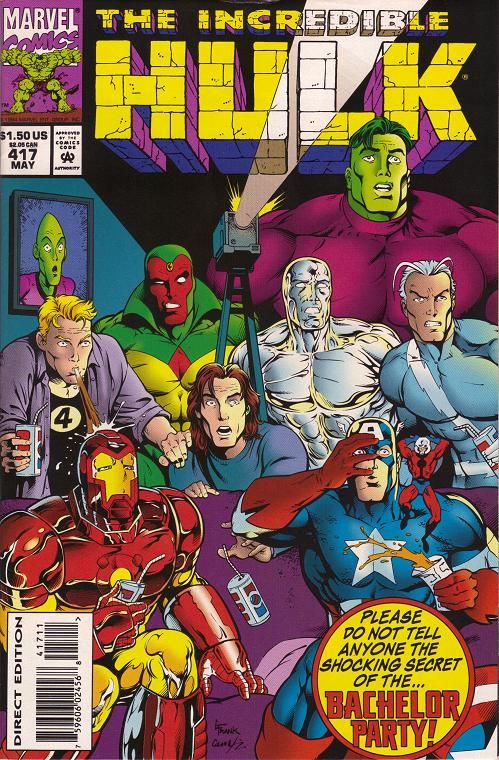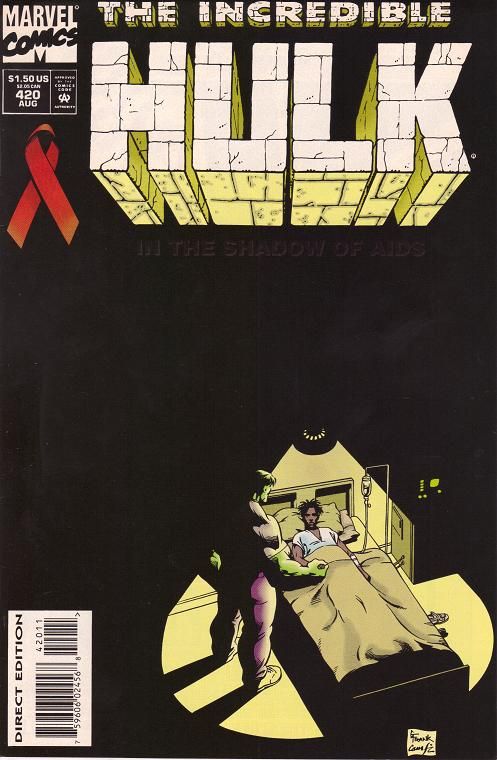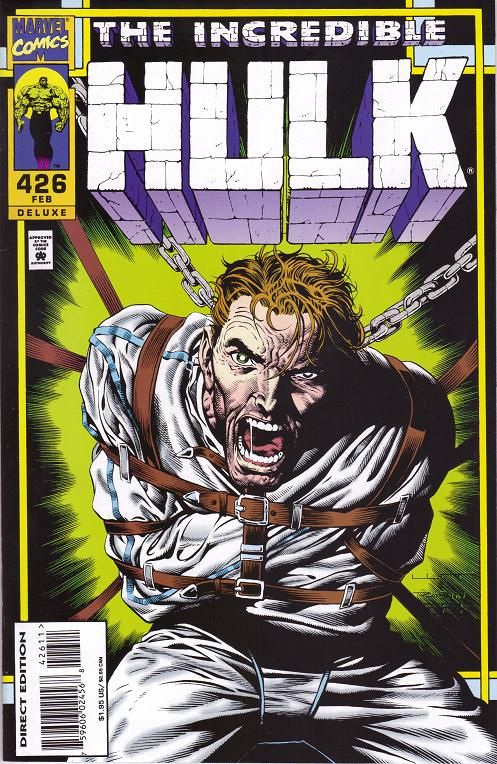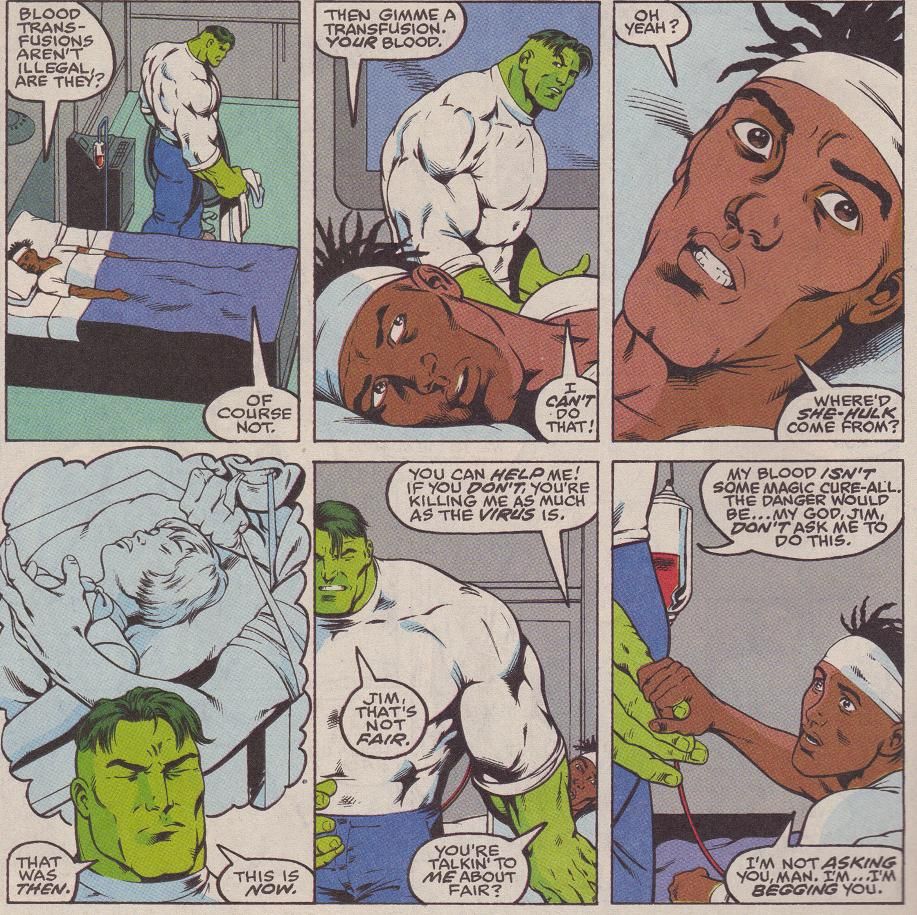Yes, it's the fourth post about Peter David's run on The Incredible Hulk. But will it be ... the last????
The Incredible Hulk by Peter David (writer), Gary Frank (penciler, issues #403-411, 413-418, 420-423, 425), Jan Duursema (penciler, issue #402), Paul Pelletier (penciler, issues #407-412), Roger Cruz (penciler, issue #419), Darick Robertson (penciler, issue #424), Liam Sharp (penciler, issues #425-426), George Pérez (artist, Future Imperfect), Cam Smith (inker, issues #403-422, 425), Mark Farmer (inker, issue #402), Josef Rubinstein (inker, issue #423), Fred Fredericks (inker, issue #423), Ron Boyd (inker, issue #424), Robin Riggs (inker, issues #425-426), Joe Rosen (letterer), Steve Buccellato (colorist, issue #402), Glynis Oliver (colorist, issues #403-414, 416-426), John Kalisz (colorist, issue #415), and Tom Smith (colorist, Future Imperfect).
Marvel, 27 issues (#402-426 of "volume 1," Future Imperfect #1-2), cover dated February 1993-February 1995.
Many people thought the previous installment, issues #368-401, should have contained these as well, as this continues the story of the "integrated" Hulk, which ends fairly decisively in issue #425. However, while it's true that Banner is integrated throughout most of this section of David's run (although cracks are showing throughout), I split them up because of a couple of reasons: 1. That would have been an extremely long post, and I'm long-winded enough as it is; 2. In the first section, Banner was learning about the Pantheon and becoming part of it, while in this section, he's running the show. So there!
Of course, the main theme running throughout this section of the run is Bruce's disintegration as he finds it harder and harder to control the monster within. This has always been an interesting part of the Hulk's psyche, because when normal people get angry and punch something - like a wall, not another person - they don't cause the house to fall down. Bruce, of course, always had to keep his emotions in check to avoid turning into the Hulk, and as we saw in issue #372, even when the change is dictated by day and night, the green, angry Hulk can break through. Then, once Bruce is integrated into the "Dr. Banner" Hulk that becomes the leader of the Pantheon, he has to worry about losing control of his emotions, because he's still one of the most powerful beings on the planet. David, of course, twists this problem in issue #425, when the Hulk, enraged because he thinks Betty has been killed, turns into ... Bruce Banner. His mind has created a failsafe for when the Hulk loses control - he becomes a man, unable to do much damage except to himself. David has once again upped the ante in terms of how we think of the Hulk and his multiple personalities. With that one image of Bruce mindlessly raging as Achilles beats his now weak body, we see clearly that these are not aspects of one personality, but a true split that exists within Bruce's mind to make sure the rage doesn't spill over and kill everyone he loves. It's a disturbing image for a mainstream superhero comic, and it's just a part of why David's run is so magnificent. The shadow of David and George Pérez's Future Imperfect looms over the latter half of the run, as well. I'm not sure of the chronology (Future Imperfect is cover dated December 1992 and January 1993, meaning it showed up before issue #402, if those dates correlate correctly - I don't have the original issues, so I don't know specifically when they were released), but according to David, the events in Future Imperfect take place between issues #416 and 417, so it colors Banner's thinking in the way he goes after Agamemnon in issues #421-423. Future Imperfect is a fine story, with gorgeous Pérez art, and David leaves it up to us to decide if the Hulk's mind created the "Raging Banner" failsafe after learning he might turn into the dictator of the world (as Future Imperfect shows us) or if that was always the last resort to keep the Hulk in check.
David, as usual, manages to fit this psychological breakdown into the framework of a superhero epic, and this section of his run is really the most superheroic, as Banner takes over the Pantheon and becomes much more involved in world affairs.
Interestingly enough, much of the tension in these issues stem not from external enemies, but from within the Pantheon itself, as the soap opera shenanigans of the participants begin to strain relationships. The first story (issues #402-404) features the Red Skull doing dastardly things, while issues #407-409 flow out of what the Skull had planned. Issues #410-411 actually show the Hulk doing something with the vast resources of the Pantheon, as he rescues an old flame from a prison in Nebraska, where she is incarcerated for treason (which, of course, is less her fault than the fault of the evil American government). Issue #412 features the Bi-Beast, but then, for the rest of the issues in this section, the Pantheon takes center stage, from the return of Trauma and his obsessive love for Atalanta (issues #413-416, "The Troyjan War") to the the search for Agamemnon (issues #421-423, "Myth Conceptions"). Only the battle with Talos the Tamed in issue #419 is concerned with an "external" enemy, and it's not like Talos is trying to conquer the world - he just wants the Hulk to kill him in battle. It's unusual how insular this section of the run is, and it's useful to consider why that is. It comes back to how David is trying to reconcile this last bit of Banner's personality, the part that turns to rage to get what it wants. If Banner has external enemies to fight, all is right in his world. It's only when he turns inward, to examine his own leadership skills, does he become enraged.
This section of David's run is about Banner's failure as anything but the Hulk, revealing, subtly, that perhaps he's nothing but the brute. When is he most successful? When he's a leg-breaker for Michael Berengetti or a foot soldier for the Pantheon. When he tries to break out of that mold and achieve something else, it all comes crashing down. His leadership skills are suspect, because as the Hulk, he's always been able to simply brutalize his way to a solution. He's no statesman and definitely no politician. Even if the positions he takes are right - when he goes after Agamemnon in issue #421, the Pantheon supports him - he carries through poorly. Banner simply isn't capable of leading, at least not the Pantheon, which has been around longer than he's been alive and whose members have their own agendas and don't like listening to an outsider (his lack of leadership skills is a theme of Future Imperfect, as well). As we see in issues #424-425, "The Fall of the Pantheon," Banner has no hope of keeping these people together and focused on a common goal, because he's not Agamemnon and has little authority over the members of his team. Perhaps in time he might have been able to establish his authority, but he doesn't have the ability to do so instantly, and based on the trials facing the Pantheon, that's what was needed.
The most impressive issues in this run have nothing to do with the Pantheon or the Hulk battling enemies. Throughout David's run, he wrote "slice-of-life" stories very well and was even able to keep up the action. In the early part of this section, Marlo's comatose condition casts a large shadow over the principals, as Marlo's family wants to take her away from Rick and send her to a proper medical facility. Rick is less than enthused about this idea, defying even his mentor, Captain America, who tries to reason with him. The Hulk, of course, takes Rick's side, and all is solved when, at the end of issue #406, Marlo wakes up. David does this kind of issue well, as he sets up a moral dilemma (the Jones brothers have the law on their side, and even though Rick and the Hulk claim they have a moral right on their side, do they really?) that raises more questions than it answers.
The Incredible Hulk isn't really the place to debate moral issues like whether Rick has any claim to Marlo, but David at least makes the reader contemplate it. David, in fact, does this quite often - raises questions that are far too complex for mainstream superhero comics and lets us chew on them. In our gut, we want to side with Rick and the Hulk, but when we stop to think about it, why should Rick have any claim, legal or otherwise, to Marlo? They haven't been together all that long, either in "real" time or even "Marvel" time (David makes a joke about "comic book time" in issue #412, where he also plays along with John Byrne's conceit at that time that She-Hulk can break the fourth wall) - they don't even get engaged until issue #410 - so why should Rick take care of her, especially as he's not, you know, a doctor? David takes care of that problem, of course, because Marlo simply "wakes up," with absolutely no side effects of being dead and then coming back to life, so David doesn't really have to deal with the implications of Rick defying a court order and Captain America himself, but we can forgive him because most comic book writers don't even get this deep, much less provide answers. This problem comes up again in issue #420, in which Jim Wilson dies of an AIDS-related illness. This issue garnered a lot of mail, many of which focused on the fact that David wrote a story in which two people die because of AIDS, implying that there's no hope for those afflicted with HIV. The Hulk, of course, famously refuses to give Jim some of his blood, because he doesn't want another She-Hulk situation - or worse - on his hands. The parallel story in the issue features a man calling Betty's help line, telling her he's HIV-positive and that he's going to kill himself. David got a ton of flak for the issue, mainly because he didn't tell the "whole" story about people with AIDS, focusing instead on Jim and Chet, one of whom dies because he's too far gone, the other of whom is suicidal even though he doesn't actually have AIDS and won't even tell Betty his girlfriend's name so they can contact her to get tested. As Bobbie Chase points out in the letters column of issue #426, David only has 22 pages to tell a fictional story in a comic called The Incredible Hulk, so of course things are going to be left out (although David did tell stories without the Hulk in the book at all, so Chase writing that the book is NOT The Incredible Jim Wilson rings false). It gets back to the failure of monthly comic books to provide a good forum for this kind of story. David deserves credit for even bringing it up, and he forces us to think more about it. That he doesn't provide good answers (or, really, any answers) doesn't mean that it's not worth writing about.
Then there's the bachelor party and wedding issues, #417 and 418. The wedding issue is quite good, even linking back to the Hulk's confrontation with Satannish back when he was living in Las Vegas and reminding us nicely how interconnected the Marvel Universe is, as Rick's wedding has many, many guests from across the line. There's also a cameo by a certain Goth chick who was quite popular in a Neil Gaiman comic in those days (this is after, in issue #413, the Hulk clobbers Doomsday in a simulated fight).
David has always been very good at writing humor (not just puns, for those people who hate his puns), and this is evident in issue #417, in which Rick and Marlo have bachelor/bachelorette parties. There's far too much to go into here, but as the cover demands, I won't tell anyone the "shocking secret" revealed within. David even has enough room to add some serious stuff into the mix, because he's the kind of writer who uses all 22 pages to his advantage. As a single issue story that fits into the larger story arc, it's textbook comic writing. It's the kind of issue that we rarely see from Marvel and DC anymore - a story where very little happens (there's an attempted robbery, but it's played for humor) but is completely character-driven and gives us a great deal of insight into the principals. Whenever I see one of these issues these days, I tend to enjoy it more than the action-packed ones, as these issues usually force the writer to think about the characters, and David is extremely good at this kind of comic. The bachelor/bachelorette parties are wonderful scenes, and make us care more about the characters than we might otherwise.
Gary Frank is the last of the four great artists to work with David on The Incredible Hulk. One could make the argument that Todd McFarlane isn't as good as the three who followed him, but it's also arguable that he is a "great" artist in the sense that he is famous and very influential. After Frank left, the quality of the art declined, not necessarily because the artist weren't any good, but because they didn't stick around long enough to forge much synergy with David. If McFarlane made the Hulk a monster, and Purves made him a gangster, and Keown made him a superhero, Frank's style meshed well with Keown's, and he continued the superhero look quite well, with clean lines and bold layouts. The biggest problem with Frank's art is, ironically, the Hulk himself, as Frank made his head too small for his body, which, combined with his bigger arms, made him look downright goofy too often. Everyone around Banner looks great (Frank's Silver Surfer, for instance, is phenomenal), and although Banner's size isn't a problem - he should be bigger than everyone - his head is just strange. In a odd coincidence, Frank drew 20 issues of The Incredible Hulk - which is average number of issues for the four most famous artists to work with David (Keown, 27; Frank, 20; Purves, 19; McFarlane, 14). David didn't have them for long, but he got the most out of them!
It's interesting to consider what might have been with The Incredible Hulk as we get the transition from Frank to Liam Sharp. David, as I've mentioned before, seemed to either switch the tone of the book to suit his artist or find artists who fit the way the book was going, and in issues #425 and 426, we see that Sharp is a bit weirder than either Frank or Keown, with a darker edge and a decidedly different way of laying out a book. Issue #426, which acts as a coda to the Frank run and shows the Raging Banner in an asylum and Betty on the operating table, is a wonderful comic to look at, as Sharp shrinks panels and crams them onto the page, making the book far more claustrophobic than anything Frank had done. He succumbs a bit too much to the mid-1990s Image-influenced aesthetic, but his Hulk is more monstrous than anything we've seen since McFarlane, and Sharp's Hulk is more dangerous-looking than even McFarlane's was. It signaled an interesting shift in the book, but we'll have to wait and see if the next chapter in Banner's life is worthy of being Comics You Should Own!
Unfortunately, these issues are not in trade yet (with the exception of Future Imperfect, the most recent printing of which comes with David and Keown's contribution to Marvel's The End series), but presumably Marvel is working on Visionaries trades as we speak! Well, I hope they are. It takes a while for those to come out, so let's cross our fingers that they'll be out in the next few years. That would be nice.
The archives remain incomplete, but there's still plenty of comics to check out there. And who knows what'll be next in the series! Will the rest of David's run make the cut?

